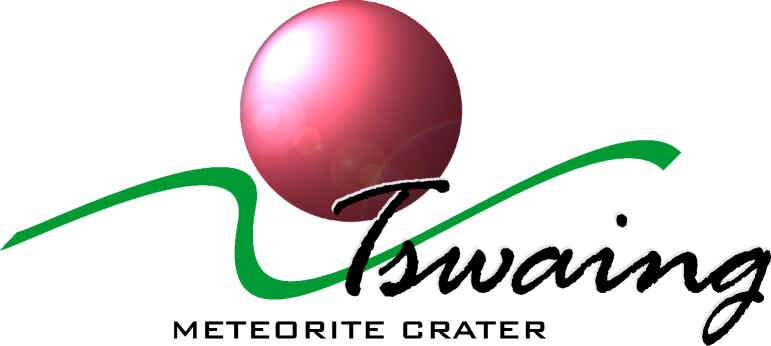|
View of crater lake during dry (winter) season (courtesy National Cultural History Museum) |
 |
|
The Crater Lake |
|
| Tswaing is the only example of a lake occupying a meteorite impact crater in southern Africa. The lake is rich in dissolved carbonates and chloride salts, predominantly of sodium, which led to its exploitation as a source of soda brines from 1912 until 1956. Prior to the commercial exploitation of soda brines the floor of the crater was covered by a shallow, seasonal pool, which collected water run-off during the summer months and evaporated to dryness each year. The present body of water has filled the shallow excavations that were dug during the period when soda and salt deposits were commercially exploited. In 1973 the Pratley Mineral Exploration Company drilled a borehole through approximately 90 m of accumulated lake sediments, reaching a final depth of 172 m. This borehole penetrated a zone of strong artesian flows that now contribute an important source of water and salts to the lake. The lake is unusually shallow (less than 3 m deep) and is meromictic, meaning that the bottom waters never mix with the surface waters, and also hypersaline, with a bottom water salinity of more than 200 grammes per litre. Laboratory examination of samples from the lake revealed high levels of trace elements and dense populations of bacteria and cyanobacteria. The water cycle of the lake is governed by rainfall, evaporation and the inflow of artesian spring water. Direct rainfall and surface run-off from the surrounding crater slopes provide the major proportion of water to the lake. A spring located west of the lake is the major source of artesian water. Its water can be classified as an alkali-carbonate type, similar, in ionic proportions, to the water of the well-known thermal springs at the town of Warmbaths, some 60 km to the north. The ionic proportions of both water types are characteristic of waters from igneous alkaline rocks. The above three sources of inflowing water to the crater lake used to contribute an estimated total salt load of 114 tonnes per year to the lake. The artesian springs contributed about 72,4% of the salt load, direct rainfall on the lake surface some 1,3%, whilst surface run-off contributed 26,3%. A portion of the salt load contributed by surface run-off represents the return of salts that were lost from the lake by infiltration into the marginal sediments. In common with alkaline, saline lakes elsewhere in the world, the biological component of the Tswaing lake is dominated by large populations of planktonic and benthic-blue algae and bacteria. In addition, a few species of diatoms inhabit the artesian spring with its feeder stream and the marginal benthic algal mats. Very little information is thus far available on the bacterial populations of the Tswaing crater lake. The predominant planktonic bacteria seem to be species of Halobacter, whilst a dense population of photosynthetic sulphur bacteria (possibly Chlorobium sp.) occupy a distinct layer immediately above the zone of maximum temperature. Zooplankton and fish are prevented from colonising the lake by the regular patterns of nocturnal deoxygenation. The few species of invertebrates found in the lake (nematode worms and brine flies) are confined to the surface. Several species of waders and water-fowl frequent the edges of the lake, where they feed on brine flies. No aquatic vertebrates are found within the lake. A single species of salt-tolerant sedge (Scirpus maritime) grows in and along the low-salinity feeder stream from the artesian spring. Human intervention in the form of a number of deep boreholes has been responsible for the gradually changing mineral composition of the crater lake over the past decades. The result is a much-reduced deposition of sodium minerals. |
|
| (Source: PARTRIDGE, T C et al, 1999, Investigations into the origin, age and palaeoenvironments of the Pretoria Saltpan. Memoir No 85 of the Council for Geoscience. Pretoria: Council for Geoscience. Available at the Council for Geoscience, Pretoria, South Africa) | |
| All intellectual property rights, including but not limited to copyright and trademarks, vested in the material contained on the NFI website is held by the NFI and may not be copied, reproduced, adapted, published or distributed in any form whatsoever without the prior written consent of the responsible person at the NFI. | |
